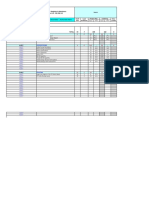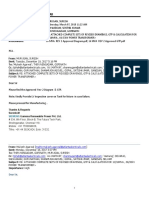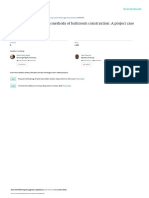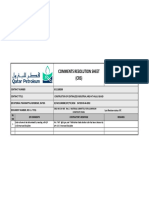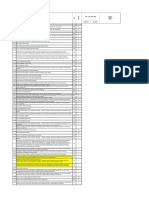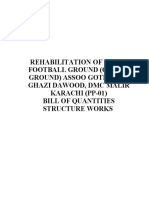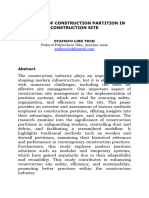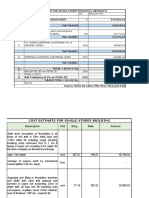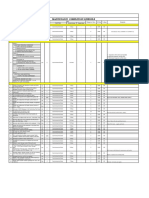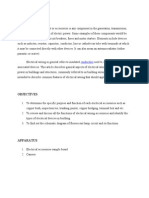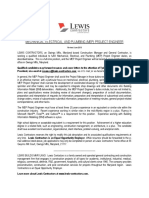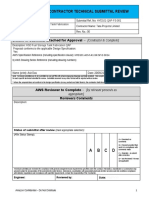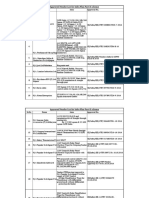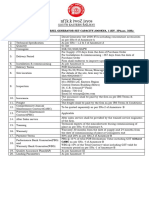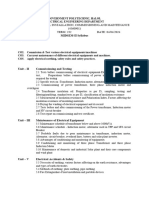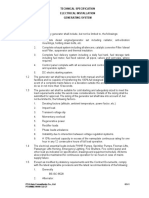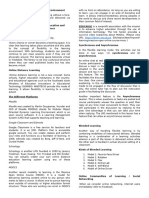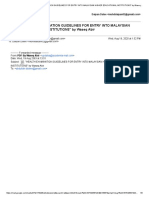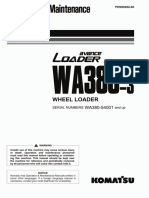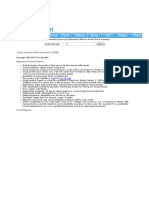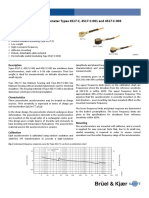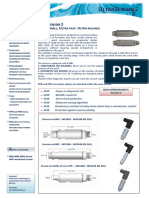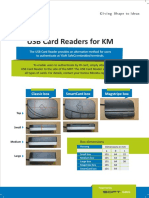TS Generator Sets
TS Generator Sets
Uploaded by
zulkazaCopyright:
Available Formats
TS Generator Sets
TS Generator Sets
Uploaded by
zulkazaCopyright
Available Formats
Share this document
Did you find this document useful?
Is this content inappropriate?
Copyright:
Available Formats
TS Generator Sets
TS Generator Sets
Uploaded by
zulkazaCopyright:
Available Formats
BELIBIS PROJECT – POWER PLANT PART 1 – SECTION 3 DOC.
NO : BP/TS/P1S3/DG
JOB NO: REV NO : 0
DIESEL GENERATOR POWER PLANT TECHNICAL SPECIFICATIONS 08:10:10
– TECHNICAL SPECIFICATIONS
TECHNICAL SPECIFICATIONS
1. Technical Requirements – Diesel Generator Sets
1.1. Work Included
Work included for the complete installation shall not be limited to the following items:
1.1.1. Manufacture, test at works, deliver to site, install, test and commission diesel engine
driven, 415 V generators
1.1.2. Auxiliary equipment
1.1.3. Daily service oil tank and piping
1.1.4. Exhaust system piping and insulation
1.1.5. Cooling water system and heat exchanger etc
1.1.6. Earthing
1.1.7. D.C supply systems
1.1.8. 380 V cables, ladders and trays, etc
1.1.9. Acoustic system
1.2. Submittal – Tender Stages
SIME DARBY PLANTATION SDN. BHD.
Energy and Utility Services
Engineering
BELIBIS PROJECT – POWER PLANT PART 1 – SECTION 3 DOC. NO : BP/TS/P1S3/DG
JOB NO: REV NO : 0
DIESEL GENERATOR POWER PLANT TECHNICAL SPECIFICATIONS 08:10:10
– TECHNICAL SPECIFICATIONS
1.2.1. Catalogue of complete generator set, engine and alternator, technical data including
guaranteed sound power levels and/or sound pressure levels of the equipment, and
maximum transient voltage and frequency of the generator, fuel consumption, losses,
efficiency etc. Data submitted shall be considered as guaranteed values
1.2.2. Type test certificates of alternators by internationally recognized independent testing
laboratory
1.2.3. GA and dimensioned drawings of complete generator set and plinth dimensions and
relevant technical details
1.2.4. The generator set manufacturer shall state the country of origin of the main parts of
the generator set and all associated components
1.2.5. For maintenance and overhaul at site the manufacturer shall indicate the nearest
service organization for the location
1.2.6. List of equipment and tools recommended by manufacturer for on-site maintenance
and commissioning
1.2.7. Type test certificates for Moulded Case Circuit Breaker, Air Circuit Breaker from
internationally recognized independent testing laboratories, such as ASTA, UL,KEMA
1.3. Submittal - Construction Stage
1.3.1. To repeat the above tender stage submission
1.3.2. A complete scaled drawing showing the exact generator system layout including all
components and accessories being provided or required for operation as specified
1.3.3. Engine manufacturer’s catalogue cut sheets, performance data, detailed drawings,
power output curves, and fuel consumption curves which relate to the design criteria
specified
1.3.4. Generator manufacturer’s catalogue cut sheets, detailed drawings and performance
data
1.3.5. Complete list of materials and catalogue cuts of all components being provided
1.3.6. Complete detailed control and wiring diagram of the system
SIME DARBY PLANTATION SDN. BHD.
Energy and Utility Services
Engineering
BELIBIS PROJECT – POWER PLANT PART 1 – SECTION 3 DOC. NO : BP/TS/P1S3/DG
JOB NO: REV NO : 0
DIESEL GENERATOR POWER PLANT TECHNICAL SPECIFICATIONS 08:10:10
– TECHNICAL SPECIFICATIONS
1.3.7. Plinths size
1.3.8. Certified factory tests/routine tests are to be provided to demonstrate all performance
requirements plus ½ hour at 25% load, 1/2 hour at 50% load, 1hour at 75% load, 1 hour at
100% load and 1 hour at 110% load. Readings of the following to be taken every 15
minutes:-
1. Oil pressure, engine lubricating
2. Water temperature, oil temperature
3. Ambient temperature
4. RPM
5. Power Factor
6. Frequency
7. Amperes on all phases
8. Voltage on all phases
9. Hour run counter
10. Paperless recording off all transient response
11. Relative Humidity
12. Load, percentage of load, KW, KVA
13. Time
14. Nameplate information
1.3.9. Dimensions of foundations, structural loading data for coordination with foundation
engineer etc.
1.3.10. Inspection and Acceptance Test
a. Type test and routine test reports prior to acceptance tests
SIME DARBY PLANTATION SDN. BHD.
Energy and Utility Services
Engineering
BELIBIS PROJECT – POWER PLANT PART 1 – SECTION 3 DOC. NO : BP/TS/P1S3/DG
JOB NO: REV NO : 0
DIESEL GENERATOR POWER PLANT TECHNICAL SPECIFICATIONS 08:10:10
– TECHNICAL SPECIFICATIONS
b. Acceptance test reports after tests
c. Packaging, transportation and storage notes
1.4. Submittal - Site Installation
1.4.1. Installation methods/Work method statements prior to installation work
1.4.2. Pre-commissioning test procedures prior to pre-commissioning testing
1.4.3. Pre-commissioning test records subsequent to testing
1.5. Submittal - Inspection and Commissioning Test
1.5.1. Site test reports prior to commissioning test
1.5.2. Commissioning test reports after testing
1.5.3. O&M manuals
1.5.4. As-built AutoCad drawings
1.6. Quality Assurance
Except as modified by the Contract Documents, comply with the latest applicable provisions and
latest recommendation of the following:-
1. IEC 60034-1 Rotating Electrical Machines.
Part 1-Rating and Performance.
2. IEC 60034-4 Rotating Electrical Machines.
Part 4 – Methods for Determining Synchronous Machine
Quantities From Tests
3. IEC 60034-5 Rotating Electrical Machines.
Part 5 – Classification of Degrees of Protection Provided by
Enclosures for Rotating Machine
4. IEC 60034-6 Rotating electrical Machines.
SIME DARBY PLANTATION SDN. BHD.
Energy and Utility Services
Engineering
BELIBIS PROJECT – POWER PLANT PART 1 – SECTION 3 DOC. NO : BP/TS/P1S3/DG
JOB NO: REV NO : 0
DIESEL GENERATOR POWER PLANT TECHNICAL SPECIFICATIONS 08:10:10
– TECHNICAL SPECIFICATIONS
Part 6 – Methods of Cooling (IC Code)
5. IEC 60034-7 Rotating Electrical Machines
Part 7 – Classification Types of Construction, Mounting
Arrangements and Terminal Box Position (IM Code)
6. IEC 60034-8 Rotating Electrical Machines.
Part 8 – Terminal Markings and Direction of Rotation of Rotating
Machines.
7. IEC 60034-9 Rotating Electrical Machines.
Part 9 – Noise Limits.
8. IEC 60034-14 Rotating Electrical Machines.
Part 14 – Mechanical Vibration of Certain Machines with Shaft
Heights 56mm and Higher – Measurement, Evaluation and Limit
of the Vibration Severity.
9. IEC 60085 Electrical Insulation – Thermal Classification
10. IEC 60364-5-54 Electrical Installations of Buildings.
Part 5-54 – Selection and Erection of Electrical Equipment
Earthing Arrangements, Protective Conductors and Protective
Bonding Conductors
11. IEC 60947-3 Low –voltage Switchgear and Controlgear -
Parts 3: Switches – Disconnectors, Switch Disconnectors and
Fuse-combination Units
12. IEC 60529 Degrees of Protection Provided by Enclosures (IP Code).
13. BS EN 210:2000 Steel Drums Non Removable Head (Tight Head) Drums
with a capacity of 216.5 Liters
14. BS 1387 Specifications for Screwed and Socketed Steel Tubes
and Tubular and for Plain End Steel Suitable for
SIME DARBY PLANTATION SDN. BHD.
Energy and Utility Services
Engineering
BELIBIS PROJECT – POWER PLANT PART 1 – SECTION 3 DOC. NO : BP/TS/P1S3/DG
JOB NO: REV NO : 0
DIESEL GENERATOR POWER PLANT TECHNICAL SPECIFICATIONS 08:10:10
– TECHNICAL SPECIFICATIONS
Welding or for Screwing to BS 21 pipe Threads.
15. ISO 5011:2000 Inlet Air Cleaning Equipment for Internal Combustion
Engines and Compressors- Performance Testing
16. BS 2869 Specifications for Fuel Oils for Agricultural, Domestic
and Industrial Engines and Boilers
17. BS 3900 Pt. E7 Methods of Tests for Paints
Part E7 –Resistance to Impact (Falling Ball Test)
18. ASTM D3359-02 Standard Test Methods for Measuring Adhesion by Tape
Test ASTM International
19. BS 3900 Pt.F2 Methods of Tests for Paints
Part E2 – Determination of Resistance to Humidity
(Cyclic Condensation)
20. BS5169 Specifications for Fusion Welded Steel Air Receivers
21. BS 6861-2:1997 Mechanical Vibration, Balance Quality Requirements of
Rigid Rotors, Balance Errors.
22. BS 5514 Pt.1 Reciprocating Internal Combustion Engines-
(ISO 30461-1) Performance-Part 1: Declaration of Power,
Fuel and Lubricating Oil Consumption and Test
Methods-Additional requirement for Engines for
General Use
.
23. BS 5514 Pt.3 Reciprocating Internal Combustion Engines:
(ISO 3046-3) Test Measurements.
24. BS 5514 Pt.4 Reciprocating Internal Combustion Engines:
(ISO 3046-4) Speed Governing
25. BS 5514 Pt.5 Reciprocating Internal Combustion Engines:
SIME DARBY PLANTATION SDN. BHD.
Energy and Utility Services
Engineering
BELIBIS PROJECT – POWER PLANT PART 1 – SECTION 3 DOC. NO : BP/TS/P1S3/DG
JOB NO: REV NO : 0
DIESEL GENERATOR POWER PLANT TECHNICAL SPECIFICATIONS 08:10:10
– TECHNICAL SPECIFICATIONS
(ISO 3046-4) Performance –Part 5: Torsional Vibrations.
26. BS 5514 Pt.6 Reciprocating Internal Combustion Engines:
(ISO 3046-6) Specification for Overspeed Protection.
27. BS 7079 Preparation of Steel Substrate Before
Application of Paints and Related Products.
Reciprocating internal combustion engine driven
alternating current generating set
-Application, ratings and performance
28. ISO 8528 Pt.2 Reciprocating internal combustion engine driven
alternating current generating set
-Engines
29. ISO 8528 Pt.3 Reciprocating internal combustion engine driven
alternating current generating set
-Alternating current generators for generating sets
30. ISO 8528 Pt.4 Reciprocating internal combustion engine driven
alternating current generating set
-Controlgear and switchgear
31. ISO 8528 Pt.5 Reciprocating internal combustion engine driven
alternating current generating set
-Generating sets
32. ISO 8528 Pt.6 Reciprocating internal combustion engine driven
alternating current generating set.
2. Products
2.1. Description of Operation - The generator sets shall provide power for all machinery and services
in the Belibis refinery complex via cables and distribution boards.
2.2.The operation of the generator sets shall be in either automatic or manual modes. The
automatic operation of the generator sets could be triggered remotely from a control room or
locally from a master controller located in the generator hall. The automatic operation is
SIME DARBY PLANTATION SDN. BHD.
Energy and Utility Services
Engineering
BELIBIS PROJECT – POWER PLANT PART 1 – SECTION 3 DOC. NO : BP/TS/P1S3/DG
JOB NO: REV NO : 0
DIESEL GENERATOR POWER PLANT TECHNICAL SPECIFICATIONS 08:10:10
– TECHNICAL SPECIFICATIONS
achieved through primary and secondary controls. The primary control is performed through
individual Generator Load Control Module that is connected to individual engine governor and
each generator’s AVR (automatic voltage regulator). Through such connections the voltage,
frequency and power of the individual generator could be regulated. The module shall also be
providing the necessary protection for the individual generator and engine.
2.3. Design and Construction
2.3.1. Except as amended in this specification, the manufacturing performance, and testing of
the engines and alternator sets shall be in accordance with the relevant parts of BS5514,
ISO 3046, ISO 8528 and IEC 60034 respectively.
2.3.2. The complete generator set installation shall be capable of successfully providing power
to start and carry load within 10 seconds and run continuously at full load under normal
conditions.
2.3.3. Ambient conditions – each set shall be capable of providing full-load under the
following ambient conditions;
a. Maximum temperature : 45 C
b. Minimum temperature : 25
c. Humidity : 80% - 90%
2.3.4. All generator sets shall be installed indoor with proper ventilation.
2.3.5. Alternator rating shall be as indicated on the Contract Documents.
2.3.6. Rated power factor shall be : 0.80
2.3.7. Number of phases/wire : Three (3) / four (4) winding
2.3.8. Connection : Star-connected with neutral earthed
SIME DARBY PLANTATION SDN. BHD.
Energy and Utility Services
Engineering
BELIBIS PROJECT – POWER PLANT PART 1 – SECTION 3 DOC. NO : BP/TS/P1S3/DG
JOB NO: REV NO : 0
DIESEL GENERATOR POWER PLANT TECHNICAL SPECIFICATIONS 08:10:10
– TECHNICAL SPECIFICATIONS
2.3.9. Steady-state nominal frequency at rated power is 50 hertz. Frequency shall be
manually adjustable from 49 to 52 hertz. Alternator speed at nominal frequency shall be
1,500 revolutions per minute. (Max RPM)
2.3.10. Steady state nominal line-to-line voltage at rated power shall be 380 volts. Voltage shall
be manually adjustable from plus to minus 10 percent of nominal voltage.
2.3.11. Voltage Regulation
a. Voltage shall not exceed plus or minus 1 percent (difference in average voltage between
no-load steady state and full-load steady state).
b. Voltage steady-load bandwidth shall not exceed ±½ percent.
c. Generator must be able to accept a one step load 100% at 0.8 power factor as per NFPA
110.
d. Voltage Transient Performance
I. Voltage dip with 75% step application at 0.8 power factor up to full load
change shall not exceed 20 percent.
II. Voltage rise with 75% step removal at 0.8 power factor up to full load change shall not
exceed 18 %
III. Recovery time shall not exceed 4 seconds
2.3.12. Frequency Regulation
a. Frequency (difference in average frequency between no-load steady state and full-load
steady state) shall be from 0 percent to 5 percent. It shall be adjusted at Works to 0
percent isochronously.
b. Frequency steady-load bandwidth shall not exceed plus 1 percent.
SIME DARBY PLANTATION SDN. BHD.
Energy and Utility Services
Engineering
BELIBIS PROJECT – POWER PLANT PART 1 – SECTION 3 DOC. NO : BP/TS/P1S3/DG
JOB NO: REV NO : 0
DIESEL GENERATOR POWER PLANT TECHNICAL SPECIFICATIONS 08:10:10
– TECHNICAL SPECIFICATIONS
c. Generator must be able to accept at one step load 100% at 0.8 power factor as per
NFPA 110.
d. Frequency Transient Performance
I. Frequency dip with 75% step application at 0.8 power factor up to full load change
shall not exceed 10 percent.
II. Frequency dip with 75% step application at 0.8 power factor up to full load change
shall not exceed 8 percent.
III. Recovery time shall not exceed 4 seconds.
e. Upon cold start-up, voltage and frequency must stabilize within their specified
bandwidths at approximately the same time (difference shall not exceeds 2 seconds).
2.3.13. The noise level shall not be more than 75dB at one meters distance outside the
generator room or to the level complying with the requirements of the local Departmental
of Environmental, whichever is less. The noise level at the boundary shall not exceed
65dBA during the night time. The contractor shall be required to coordinate with other
Contractor(s) on the provision of noise abatement measures to ensure that the limit is not
exceed anywhere outside the generator room.
2.3.14. Reverberation noise in the genset to be added into calculation for noise control.
2.3.15. 3dBA needs to be added into calculation for 2 number of generator sets.
2.3.16. The following acoustics equipment shall installed as minimum requirement:-
a. Air discharge duct type silencer
b. Air intake duct type silencer
SIME DARBY PLANTATION SDN. BHD.
Energy and Utility Services
Engineering
BELIBIS PROJECT – POWER PLANT PART 1 – SECTION 3 DOC. NO : BP/TS/P1S3/DG
JOB NO: REV NO : 0
DIESEL GENERATOR POWER PLANT TECHNICAL SPECIFICATIONS 08:10:10
– TECHNICAL SPECIFICATIONS
c. Primary exhaust silencer
d. Secondary exhaust silencer
e. Acoustic Door
2.4.Engine
2.4.1. General
a. The diesel engine shall be of the compression ignition, G3 performance class, four
stroke, totally enclosed, water-cooled direct injection, vertical multi-cylinder, capable of
cold starting with two inlet and two exhaust valve per cylinder, toroidal cavity pistons
and a common bore and stroke. The engine shall be turbo charged or turbo charged
with after cooling of the charge air and shall be suitable for operation at a speed of 1500
R.P.M (maximum RPM)
b. The brake horsepower of the engine, with all attached accessories as described below,
shall not be less than that required by the full load-rating of the alternator taking into
consideration efficiency losses, plus a reserve factor at least nominal 10 percent under
environmental conditions of altitude less than 925 meters or equivalent and maximum
ambient temperature.
c. Engine speed is not restricted except to the extent that the engine RPM shall not exceed
the engine manufacturer published curves and shall be suitable for direct connection to
the alternator.
d. The engine with individual cylinder head shall be of multi-cylinder design, either in line
or VEE arrangement. Cylinder liners shall be wet type. The pistons shall be trunk or
crosshead type, oil-cooled, of either cast-iron or aluminums alloy. Pistons shall be fitted
with both compression and oil-control rings. The crankshaft shall be drip-forged,
electrically hardened, and dynamically balanced. Connecting rods and main bearings
shall be of the precision removable shell type.
SIME DARBY PLANTATION SDN. BHD.
Energy and Utility Services
Engineering
BELIBIS PROJECT – POWER PLANT PART 1 – SECTION 3 DOC. NO : BP/TS/P1S3/DG
JOB NO: REV NO : 0
DIESEL GENERATOR POWER PLANT TECHNICAL SPECIFICATIONS 08:10:10
– TECHNICAL SPECIFICATIONS
e. The flywheel shall be both statically and dynamically balanced. The flywheel shall be
torsion ally approved, compatible with the generator and ground to S.A.E tolerances
and free from harmful eccentricities.
2.5.Governor System
2.5.1. The governor system shall consist of electronic control unit, actuator and governor
suitable for automatic starting and speed control. The electronic control unit shall have the
following functions:-
a. Idle and rated speed setting
b. An adjustable ramp from the idle rated speed
2.5.2. An electronic control unit with adjustable droop mechanism maintaining the engine
speed within the limits of ISO 8528-2 and ISO 3046-1 , and means for manual and
automatic adjustment of the governed speed shall incorporated with the engine. In
addition, means of protection against overspeed shall be provided. The governor shall
have sufficient sensitivity to control the automatic starting function and to maintain the
engine speed within the limits specified in ISO 8528-2.
2.5.3. The class of governing shall be G3 in accordance with the requirements of ISO 8528-
2.The Contractor shall provide full details and characteristics of the governor.
2.6.Cooling System
2.6.1. Engine mounted radiator shall be provided. The radiator cooling system shall be
complete with blower-type fan, water manifold and temperature control valve. In
addition, gear-driven engine water-circulating pump shall be incorporated.
2.6.2. A heat exchanger of a type and capacity recommended by the engine manufacturer
shall be provided. A solenoid valve shall be furnished and mounted on the cooling water
inlet side of the heat exchanger. The solenoid valve shall open on the engine start and
SIME DARBY PLANTATION SDN. BHD.
Energy and Utility Services
Engineering
BELIBIS PROJECT – POWER PLANT PART 1 – SECTION 3 DOC. NO : BP/TS/P1S3/DG
JOB NO: REV NO : 0
DIESEL GENERATOR POWER PLANT TECHNICAL SPECIFICATIONS 08:10:10
– TECHNICAL SPECIFICATIONS
close on engine stop. A manually operated valve to ensure capacity shall be installed
bypassing the solenoid to ensure cooling water supply in case of solenoid valve failure.
2.6.3. An expansion / surge tank having capacity for expansion equal to or no less than 10% of
the jacket water system shall be supplied. The system shall have a pressure/vacuum relief
control cap on the filler.
2.6.4. The engine cooling system shall include one or more spin-on type engine water filter
which will treat the coolant and prevent corrosion and scale deposits inside the cooling
system.
2.6.5. The engine shall be equipped with centrifugal type water circulating pump and
thermostat valve to maintain the engine recommended temperature level.
2.6.6. The engine cooling system shall be pre-treated by the engine supplier for the inhibition
of internal corrosion.
2.6.7. The radiator blower-type fan shall be rated to cater for the static pressure drops across
the intake and exhaust air silencers without derating the generator capacity.
2.7. Air Intake
2.7.1. Each turbocharger shall incorporate an integral lubricating oil system. Suitable flexible
pipe connections shall be used on all entry and discharge terminals selected such that no
loads are transmitted from ducting/pipes to the turbo charger casings.
2.7.2. A dry type air cleaner with replaceable elements and silencer shall be furnished as
recommended by the engine manufacturer. If a dry type air cleaner is used, the filter shall
be equipped with moisture eliminator and restriction gauge.
2.8.Exhaust System
2.8.1. The generator set shall be complete with exhaust manifold guard, exhaust silencer,
flexible sections, and exhaust piping from engine to silencer, adapters and connecting
parts.
SIME DARBY PLANTATION SDN. BHD.
Energy and Utility Services
Engineering
BELIBIS PROJECT – POWER PLANT PART 1 – SECTION 3 DOC. NO : BP/TS/P1S3/DG
JOB NO: REV NO : 0
DIESEL GENERATOR POWER PLANT TECHNICAL SPECIFICATIONS 08:10:10
– TECHNICAL SPECIFICATIONS
2.8.2. The silencer shall be critical grade silencing, bottom inlet and outlet horizontal type,
drain cock at lowest point and one (1) accessible cleanout port. It shall be finished in rust-
preventive primer, heat-resistance paint and completely insulated.
2.8.3. One (1) flexible exhaust pipe section shall be connected between the exhaust pipe and
the engine exhaust manifold. It shall be smoke tight, of stainless steel construction and has
the same inside diameter as the exhaust pipe. The section shall flex to permit relative
motion of engine and exhaust pipe up to 25mm in any direction without strain on engine
manifold or exhaust piping.
2.8.4. The following adapters and connecting parts shall be provided as required:
a. To connect silencer inlet to exhaust pipe.
b. To connect silencer outlet to exhaust pipe.
c. To connect flexible section to engine exhaust manifold outlet flange.
d. To connect flexible section to exhaust pipe.
e. Bolts, nuts, lock-washers, and gasket required for adapters.
2.8.5. A metal manifold guard shall be provided to prevent personnel from contacting the
engine exhaust manifold if manifolds are not water-cooled. It shall be rigid construction of
open mesh or expanded metal.
2.8.6. The exhaust piping and silencer shall be insulated with 90 ⁰ C type insulation, they shall
be lagged 75 mm thick rock wool pipe insulation and protected by a 1.2 mm (16 gauge)
galvanized steel metal shield.
2.8.7. The exhaust piping shall be adequately sized to ensure the backpressure requirement of
the engine is not exceed. The exhaust system shall incorporate sufficient expansion joints
and an approved type silencer capable of reducing the noise to an acceptable level.
SIME DARBY PLANTATION SDN. BHD.
Energy and Utility Services
Engineering
BELIBIS PROJECT – POWER PLANT PART 1 – SECTION 3 DOC. NO : BP/TS/P1S3/DG
JOB NO: REV NO : 0
DIESEL GENERATOR POWER PLANT TECHNICAL SPECIFICATIONS 08:10:10
– TECHNICAL SPECIFICATIONS
2.8.8. Where the exhaust system rises above the engine, provision shall be made to prevent
any condensate flow into the engine. The exhaust piping shall be connected by a suitable
high temperature flexible connector and run overhead, well above head height, so that the
exhaust gases will be clear of the working area, and finally through the wall to
atmosphere.
2.8.9. The minimum insertion loss required for the primary exhaust silencers are :-
Octave band Frequency
In Hz 31.5 63 125 250 500 1K 2K
Insertion Loss
In dB 6 18 28 30 25 22 22
2.8.10. The Contractor shall submit insertion loss data of the silencer offered for evaluation.
2.9. Fuel Consumption
2.9.1. The Contractor shall state in the appropriate Appendix or prepare a separate chart the
fuel consumption as rated output, ¾ rated output and chart ½ rated output when the
engine is operating under the prevailing site atmospheric conditions.
2.9.2. The consumption shall be stated in both gallons/hour, liters/hour and pound per BHP
per hour and install be based on a fuel having a nett calorific value of 42.7 Mega
joules/kilogram generally complying with B.S 2869, Class A.
2.10. Fuel System
2.10.1. An integral engine driven fuel transfer pump shall be furnished to supply an adequate
quantity of fuel under all operating conditions to the engine injection system. Replaceable
fuel filter for primary and secondary filtration shall be provided. The design and
construction of the duel system shall meet NFPA requirement.
2.10.2. An enclosed, fuel injection pump with twin diaphragm type fuel lift pumps. In addition,
twin parallel fuel filters with replaceable elements shall be fitted and a 24 V shut-down
solenoid shall also be provided primary fuel filter shall also be included as a feature of the
SIME DARBY PLANTATION SDN. BHD.
Energy and Utility Services
Engineering
BELIBIS PROJECT – POWER PLANT PART 1 – SECTION 3 DOC. NO : BP/TS/P1S3/DG
JOB NO: REV NO : 0
DIESEL GENERATOR POWER PLANT TECHNICAL SPECIFICATIONS 08:10:10
– TECHNICAL SPECIFICATIONS
fuel injection system of the engine. The shut-down solenoid should be de-energized to trip
with provision for starting.
2.10.3. The diesel engine set shall be provided with a Diesel Storage Tank having a storage
capacity sufficient to allow the diesel engine to run on full load for at least twenty four (24)
hours. The tank shall be situated in the same room and complete with the following:
a. Supporting stands of sufficient height to gravity feed fuel pump.
b. Tank filling connection to exterior for vehicle delivery or electric motor pump from
barrel.
c. Fuel oil level dial gauge. Sight glass type shall also be incorporated.
d. Open vent with flame/spark arrester.
e. Drain connection and plug with sludge and sediment trap.
f. Fuel supply piping between tank and diesel engine complete with manual isolating valve
with facility for locking in the ‘OPEN’ position.
g. Inspection and clearing hole.
h. Drip tray with separate drain connection.
2.10.4. The tank shall be subjected to attest pressure of 0.33 bar (5 psi ) for period of 1 hour on
site to the approval of the owner. Compressed air or dry nitrogen may be used for the
pressure test. It is not permissible to use water for on-site testing.
2.10.5. The daily service tank shall be manufactured in accordance with B.S EN 210 for a
welded mild steel drum and be complete with an initial fill of fuel oil to B.S 2869 Class A.
The tank, supporting stand and pipework shall be finished in a corrosion resistant finish to
suit the environment with a cosmetic top coat (color to be advised).
2.10.6. All fuel piping and connections between the motorized pump and fuel storage tank, and
between the fuel storage tank and the standby generator set fuel inlet shall be of carbon
steel Schedule 40 to API with welded fittings. Flexible metallic connections shall be
provided where fuel oil lines connect to the diesel engine. A guard or protection pipe shall
be incorporated between the tank and fuel pump. Means to enable the entire fuel system
to be bled of air using a screwed plug shall be incorporated.
SIME DARBY PLANTATION SDN. BHD.
Energy and Utility Services
Engineering
BELIBIS PROJECT – POWER PLANT PART 1 – SECTION 3 DOC. NO : BP/TS/P1S3/DG
JOB NO: REV NO : 0
DIESEL GENERATOR POWER PLANT TECHNICAL SPECIFICATIONS 08:10:10
– TECHNICAL SPECIFICATIONS
2.10.7. In addition, the day tank shall be internally equipped with a level sensor for remotely
monitoring the fuel level in the day tank in “percent of maximum level”.
2.10.8. The day tank shall be fully filled-up before Certificate of Completion, after all testing
and commissioning are carried out.
2.10.9. During the refueling of the day tank, the electric fuel transfer pump shall be started
automatically. When the fuel level reaches the “FULL” level, the level switch shall trip the
starter of the electric motor pump: Should this action failed to stop, the level switch “FULL
FULL“shall be triggered and emergency stop the pump.
2.10.10. A leak-proofed bund wall with a capacity equivalent to 110% of the biggest diesel
daily tank volume shall be constructed to contain any spillage or leaking. An appropriate
drain cock shall be provided to drain off any excessive oil.
2.11. Overflow Drip Trays
2.11.1. Drip trays, or other suitable portable receptacles, shall be provided for each plant, one
each for fuel and lubricating oil overflow at the engine and fuel overflow at the day fuel
storage tank. These shall be manufactured from good quality sheet steel with welded
edges to prevent leaking, and provided with suitable external lifting handles on all sides.
2.11.2. Overflow pipes at the engine and daily service tank shall be extended, where
necessary, to a level slightly above the heights of these receptacles.
2.12. Lubrication System
2.12.1. The lubrication system shall include a sub merged suction, positive displacement oil
pump (integral with the engine) to provide a forced feed, constant pressure to all
important points. A lubricating oil filter of the replacement element type, a lubricating oil
filter of the replacement element type, a lubricating oil cooler for oil temperature control,
strainer and relief valve shall be provided.
2.12.2. Only the best quality oils and lubricants shall be used. All lubricants shall be filtered to
10 microns.
2.12.3. Where accessibility to a particular lubricating point would be difficult provision shall be
made for remote lubrication.
SIME DARBY PLANTATION SDN. BHD.
Energy and Utility Services
Engineering
BELIBIS PROJECT – POWER PLANT PART 1 – SECTION 3 DOC. NO : BP/TS/P1S3/DG
JOB NO: REV NO : 0
DIESEL GENERATOR POWER PLANT TECHNICAL SPECIFICATIONS 08:10:10
– TECHNICAL SPECIFICATIONS
2.12.4. Lubrication shall be forced feed. All lubrication pumps shall be gear driven.
2.13. Vibration Isolation
2.13.1. The diesel engine generator shall be mounted on a structural base provided by the
diesel engine manufacturer. The equipment complete with isolation system shall be
installed on a 150mm high concrete plinth over the complete floor area of the equipment.
All concrete work, all such work shall be shown in detail on shop drawings on the vibration
base and concrete plinth.
2.13.2. Generator shall be mounted on steel springs with a minimum static deflection of 25 mm
under the weight of the generator. Integral moulded rubber vibration isolators installed
between the engine and skid base is acceptable.
2.13.3. Spring shall be selected to provide a ratio of horizontal stiffness to vertical stiffness
within the range 80% - 100%. Springs shall allow 50% travel beyond rated load. Spring shall
incorporate a ribbed neoprene noise stop pad of minimum 20 mm thick (two layers of
double ribbed rubber or neoprene of maximum 60 durometer separated by 1.6mm steel
plates).
2.13.4. The method of fixing the steel spring to the generator shall ensure that the neoprene
noise stop pad is not short circuited by a rigid connection.
2.13.5. Flexible connections between the generator set and exterior system (such as fuel lines,
electrical connection, and exhaust duct shall be provided.
2.14. Starting Equipment
2.14.1. An electric starting motor with solenoid drive shall be furnished on the engine. Starting
motor shall be of the required voltage as recommended by engine manufacturer.
2.14.2. Battery Charger and Batteries
a. Each generator set shall be provided exclusively its own battery charger and battery
bank. The charger and battery bank shall have sufficient capacity for cranking start the
generator set using the electric starting motor. The duty and local requirements shall
meet the starting requirement for motor.
b. In addition, an adjustable timing device shall be built-in with the starting system to
prevent immediate consecutive operation of the starter motor, either by push-button or
SIME DARBY PLANTATION SDN. BHD.
Energy and Utility Services
Engineering
BELIBIS PROJECT – POWER PLANT PART 1 – SECTION 3 DOC. NO : BP/TS/P1S3/DG
JOB NO: REV NO : 0
DIESEL GENERATOR POWER PLANT TECHNICAL SPECIFICATIONS 08:10:10
– TECHNICAL SPECIFICATIONS
automatically remote starting device, in the event of the engine failing to fire. Such
timing device shall allow a lapse of 6 sec. to 15 sec. between each successive restart of
the starter motor so as to allow sufficient time for the starter motor to automatically
disengage itself from the engine’s cranking gear before an attempt to restart it made.
c. All electrical equipment shall be suitable for operation on a 24 volt DC battery supply.
d. A battery voltage testing meter and hydrometer, etc shall be provided for routine
maintenance.
e. Battery Charger
I. A completely automatic battery charger shall be furnished. The battery charger shall
be capable of maintaining the starting battery at full charge and shall be of the solid
state completely static type which will automatically control the charge rate
II. The charging rates shall be adjustable. An ammeter indicating the charge rate and
an automatic reset thermal overload circuit breaker to protect the rectifier assembly
and transformer shall be incorporated. The rectifier assembly shall be full wave and of
silicon type. The charger shall operate from 240 voltage normal power supply and may
be mounted either in the generator control panel or provided for wall or shelf
mounting. The high rate must be 3 amps for 12 volt systems and 4 amps for 24 volt
systems
III. A battery charge failure protection alarm unit shall be fitted in each charger unit and
arranged to sound in the event of battery voltage failing below normal float level for a
period of 10 minutes.
f. Batteries
I. Each diesel generator set assembly shall be supplied with a set of Nickel-Cadmium
Alkaline Batteries complete with storage stand and protective casing
II. Each battery set shall have a capacity at 40 oC sufficient to maintain engine cranking
speed recommended for the diesel engine through a 6 minute cycle (15 seconds
cranking) and 15 second rest in 6 consecutive cycles and a certificate shall be provided
to conform compliance with the clause
III. The batteries shall be supported on substantial frame being on a concrete plinth,
secured against displacement and located close to the diesel driver and in position
where they will not be subjected to excessive temperature, vibration, mechanical injury
SIME DARBY PLANTATION SDN. BHD.
Energy and Utility Services
Engineering
BELIBIS PROJECT – POWER PLANT PART 1 – SECTION 3 DOC. NO : BP/TS/P1S3/DG
JOB NO: REV NO : 0
DIESEL GENERATOR POWER PLANT TECHNICAL SPECIFICATIONS 08:10:10
– TECHNICAL SPECIFICATIONS
or flooding with water and shall be readily accessible for servicing. The location shall be
chosen to minimize the lead length between the battery and the diesel engine starter
2.15. Instruments and Alarm Indication
The following engine gauges and controls are to be furnished on the generator set in an
accessible and convenient location adjacent to the generator control panel:-
2.15.1. Water temperature gauge (inlet and outlet)
2.15.2. Coolant temperature gauge (inlet and outlet)
2.15.3. Oil pressure gauge
2.15.4. Oil temperature gauge
2.15.5. Governor Control
2.15.6. Turbo Charger Pressure Gauge
2.15.7. Run-Stop switch
2.15.8. Electrical and fuel controls – for use under manual starting conditions
2.15.9. Battery start and stop push button to over-ride the complete control system excluding
engine and alternator safety and interlocks
2.15.10. Emergency start and stop push button to over-ride the complete control system
excluding engine and alternator safety and interlock
2.16. Engine Protective Devices and Alarm Indicators
2.16.1. An alarm indicator panel shall be provided for generator set as part of the generator
control panel. Provide one (1) remote alarm indicator panel for the entire emergency
power system as indicated on the contract documents, one to be located in the master fire
alarm panel
2.16.2. Provide alarm indicators. When activated, these alarms shall sound audible alarms and
indicate, by means of individual lights at alarm indicator panels, which particular
malfunction is initiating the alarm. Provide 5mm high (minimum) labeling to identify the
alarm
SIME DARBY PLANTATION SDN. BHD.
Energy and Utility Services
Engineering
BELIBIS PROJECT – POWER PLANT PART 1 – SECTION 3 DOC. NO : BP/TS/P1S3/DG
JOB NO: REV NO : 0
DIESEL GENERATOR POWER PLANT TECHNICAL SPECIFICATIONS 08:10:10
– TECHNICAL SPECIFICATIONS
2.16.3. Provide a horn at each panel with silence (override) switch to silence the alarm.
Override switch shall have flashing pilot lamp labeled “Override” to indicate that alarm is
silenced. Provide power for alarm system from generator battery system.
2.16.4. Indicators and controls shall be as follows:-
Item lens Cap Colour
1. High water temperature Red
2. Approach to high water temperature Yellow
3. Low oil pressure Red
4. High oil temperature Red
5. Over speed Red
6. Cracking failure (after 60 seconds) Red
7. Generator output failure Red
8. Start/stop switch (fire control centre only) -
9. Test switch (fire control centre only) -
10. Main circuit breaker tripped Red
11. Running pilot lights for fuel oil pump Red
12. Low fuel oil (day tank) Red
13. Low fuel (main tank) Red
14. Provide voltage-free contacts for individual trouble signal to be sent to main
control SCADA
SIME DARBY PLANTATION SDN. BHD.
Energy and Utility Services
Engineering
BELIBIS PROJECT – POWER PLANT PART 1 – SECTION 3 DOC. NO : BP/TS/P1S3/DG
JOB NO: REV NO : 0
DIESEL GENERATOR POWER PLANT TECHNICAL SPECIFICATIONS 08:10:10
– TECHNICAL SPECIFICATIONS
2.16.5. Engine protection and alarm wiring shall be brought to terminal strip or block that
provides for interconnecting the engine protection system to remote alarm indicator
panel.
a. Terminal strip enclosed in junction box
b. Accessible location on electric set
2.17. Alternator and Exciter
2.17.1. General
a. The alternator shall be engine-driven, synchronous type, AC brushless, single bearing
(ball-type oil or grease lubricated) with bearing using the same grade of oil used in the
engine crankcase, with intake and open guarded exhaust meeting or exceeding all
relevant IEC Standards. The alternator shall be directly coupled to the engine prime
mover by means of flexible driving discs.
b. Alternator output shall be continuously rated (duty typeS1 as per IEC 60034-10).
c. Telephone Harmonic Factor (THF)
When tested on open circuit and at rated speed and voltage, the telephone
harmonic factor (THF) of the line-to-Iine terminal voltage as measured according to
the method spelled in lEG 60034-1 shall not exceed the following values for a rated
output of the machine:
300kW (or kVA) to 1000kW (or kVA) - THF 5%
1000kW (or kVA) to 5000kW (or kVA) - THF 3%
More than 5000kW (or kVA) - THF 1.5%
d. Sub-transient Reactance
The voltage dip shall not exceed 15% when applying the sub transient reactance value.
e. The alternator shaft shall be of rolled steel. The rotating field pole shall be bolted to the
shaft with all other rotating electrical components. This means that the shaft will be free
from electrical earth on the shaft.
f. The alternator shaft with its rotating equipment shall be dynamically balanced up to
25% over speed condition.
SIME DARBY PLANTATION SDN. BHD.
Energy and Utility Services
Engineering
BELIBIS PROJECT – POWER PLANT PART 1 – SECTION 3 DOC. NO : BP/TS/P1S3/DG
JOB NO: REV NO : 0
DIESEL GENERATOR POWER PLANT TECHNICAL SPECIFICATIONS 08:10:10
– TECHNICAL SPECIFICATIONS
g. The rotating bridge assembly shall be mechanically constructed with glass cloth
impregnated with an epoxy resin binder and shall meet all requirements of IEC
recommendation.
h. The enclosure shall have a fabricated steel main frame with a minimum thickness of
6mm, which is treated in design as a structural member of the complete diesel
generator set connecting the engine to the base for three point balanced suspension.
i. The alternator feet shall have machined surfaces at the mounting rail positions for good
axial parallelism.
j. The alternator shall be equipped with anti-condensation heaters sized to prevent
condensation during shutdown.
k. Product that are persistent or toxic to the environment or that are considered potential
carcinogens shall not be used. The use of hygroscopic materials should be avoided. The
materials used shall be selected to prevent contact corrosion.
l. Alternators shall have jacking bolts or facilities to lift the generator with the aid of a
mechanical jacking device to facilitate alignment of the alternator with the prime-
mover.
m. Alternator shall, during installation at site and subsequent maintenance work, allow for
inspection of the air gap between stator and rotor.
n. The degree of protection shall be at least: -
I. IP 21 for alternator and auxiliaries
II. IP 21 for the terminal boxes and bearing housing
2.17.2. Method of Cooling
a. Alternators shall be air-to-air, self-cooled machines with a method of cooling IC 01 -
IP23.
b. When cooling air inlets are protected by a screen, such a screen shall be of corrosion
resistant material. Mesh wire of galvanized steel is not acceptable.
2.17.3. Stator
SIME DARBY PLANTATION SDN. BHD.
Energy and Utility Services
Engineering
BELIBIS PROJECT – POWER PLANT PART 1 – SECTION 3 DOC. NO : BP/TS/P1S3/DG
JOB NO: REV NO : 0
DIESEL GENERATOR POWER PLANT TECHNICAL SPECIFICATIONS 08:10:10
– TECHNICAL SPECIFICATIONS
a. The insulation material used for the stator windings shall be of at least Class F in
accordance with lEC 60085.
b. Alternators shall have their stator windings star connected. The stator windings shall be
preformed and be made of rectangular copper conductors adequately covered with
glass silk material or the material of a comparable quality.
c. All windings shall be adequately supported, braced and blocked to provide' sufficient
rigidity and to limit end-winding vibration and subsequent cracking of the winding
insulation at the slot exits. Windings shall be capable of withstanding the dynamic forces
which result from system fault conditions.
d. Alternator frame, including bearing supports shall have sufficient strength and rigidity to
avoid distortion or increased vibration as a result of external mechanical forces, e.g.
tightening of fixing bolts.
2.17.4. Rotor
a. The insulation material used for the rotor windings shall be of at least Class F in
accordance with IEC 60085.
b. The shaft shall be made of one-piece, heat-treated forged steel.
c. Balancing of rotors at nominal speed is recommended, however, balancing below rated
speed followed by check balancing at rated speed may be acceptable. Rotors shall be
equipped with provisions, such as balancing rings, which allow the addition of balancing
weight. Balancing weight shall not be of lead or similar ductile material.
d. Rotors shall be subjected to an overspeed test at 1.2 times rated speed for duration of 1
minute. The overspeed test shall be considered as satisfactory if no permanent
abnormal deformation is apparent. This deformation can be detected if the phase angle
of unbalance has changed after the overspeed test. Details are provided in lEG 60034-1 .
2.17.5. Terminal Box
a. A terminal box of sturdy construction shall be provided with ample space for connecting
the cable.
b. The main terminal box and the star-point box shall be made of steel.
SIME DARBY PLANTATION SDN. BHD.
Energy and Utility Services
Engineering
BELIBIS PROJECT – POWER PLANT PART 1 – SECTION 3 DOC. NO : BP/TS/P1S3/DG
JOB NO: REV NO : 0
DIESEL GENERATOR POWER PLANT TECHNICAL SPECIFICATIONS 08:10:10
– TECHNICAL SPECIFICATIONS
c. The star-point box shall be located at the opposite side of the alternator from the main
terminal box. The size of the terminal box shall be sufficient to accommodate the
current transformers for the differential and negative phase sequence protection.
2.17.6. Bushings and Terminals
a. Terminal marking of the main cable connections and the direction of rotation shall be in
accordance with IEC 60034-B.
b. Terminal connections shall be constructed in such a way that direct contact between
screws, bolts or nuts and the conductor is avoided
c. Clamping devices shall be provided inside the main terminal box of machine to
separate and support the cable conductors, thereby ensuring that the ability to
withstand the short circuit current will be maintained after completion of the non-
compound filled type of termination. Materials used for clamping devices shall be non-
hygroscopic.
2.17.7. Bearings
a. The Contractor shall provide detailed data and drawings regarding the bearing
arrangement. These data shall include but not be limited to:-
I. Bearing data, e.g. type, size, clearance
II. Installation instruction
III. Bearing insulation details
b. All bearings shall be fully insulated from the alternator frame and/or bed-plate to
prevent the flow of shaft current. The method of insulation shall be permanent and non-
deteriorating. Manufacturer shall submit detailed drawings showing the proposed
insulation arrangement
c. The bearing design shall suppress hydrodynamic instabilities and provide sufficient
damping to limit rotor vibration to less than the maximum specified amplitudes while at
operating and critical speeds. The bearing house housing design shall not require
removal of the lower half of end-bells or plate, the coupling lub or the exciter to permit
replacement of the bearing liners.
SIME DARBY PLANTATION SDN. BHD.
Energy and Utility Services
Engineering
BELIBIS PROJECT – POWER PLANT PART 1 – SECTION 3 DOC. NO : BP/TS/P1S3/DG
JOB NO: REV NO : 0
DIESEL GENERATOR POWER PLANT TECHNICAL SPECIFICATIONS 08:10:10
– TECHNICAL SPECIFICATIONS
d. White metal liners and shells shall be protected against corrosion during transport and
storage. Product used for protection, shall not require extensive cleaning of the bearings
prior to commissioning of the machine
e. Rotors shall be secured during transport to avoid damage to the bearings.
2.17.8. Vibration
a. To permit evaluation of balance and vibration of rotating electrical machines, it is
necessary to measure on the machine alone. The test conditions should be properly
defined to enable reproducible tests to be carried out and to provide comparable
measurements.
b. The test conditions shall be complied to IEC 60034-14.
2.17.9. Noise Control
a. General
I. IEC 60034-9 shall be adhered to with regard to definitions, notations, measuring
equipment! Procedures and calculation methods/procedures.
2.17.10. Noise Limits
I. Requirements for equipment noise limitations shall be as specified in IEC 60034-9.
Procedures for acceptance tests are specified in IEC 60034-9.
2.17.11. Excitation System
a. The exciter shall be of brushless construction, inboard of the bearing (no external
exciters shall be considered), of 3 phase, full-wave design with S.C.R. surge suppression
generating negligible thermal losses during the normal operation and rated for a
calibrated surge voltage for protection of the rotating bridge .
b. The alternator shall have the capability of permitting the measurement of the excitation
voltage at rated speed. This voltage shall be obtained under any load condition.
c. The excitation system of the machine shall be designed for a power factor at the
generator terminals of 0.8 lagging (overexcited) at rated output and an alternator
voltage between 90% and 110% of the rated value.
SIME DARBY PLANTATION SDN. BHD.
Energy and Utility Services
Engineering
BELIBIS PROJECT – POWER PLANT PART 1 – SECTION 3 DOC. NO : BP/TS/P1S3/DG
JOB NO: REV NO : 0
DIESEL GENERATOR POWER PLANT TECHNICAL SPECIFICATIONS 08:10:10
– TECHNICAL SPECIFICATIONS
d. The current rating of the semiconductors applied in the diode bridge shall not be less
than 200% of the maximum current flowing through the elements at maximum
continuous excitation current. If parallel connection of semi-conductors is applied, the
above current rating shall not be less than 220% of the above values. The repetitive
reverse blocking voltage rating of the semiconductors applied in the diode bridge shall
be at least 200% of the maximum peak voltage generated by the main exciter. A failure
of a diode shall be detected by a diode failure monitoring device.
e. The automatic voltage regulator (AVR) controlling the DC voltage for the main exciter
field winding shall be of the electronic type. The AVR shall be equipped with a manual
control facility
f. To avoid overvoltage when the generator is suddenly disconnected from the load, a fast-
acting de-excitation system for the main exciter should be provided. Manufacturer shall
provide information regarding the maximum transient overvoltage, which may occur
when the rated load is suddenly disconnected from the generator.
2.17.12. Automatic Voltage Regulator
a. The alternator and voltage regulator shall· be designed and built by the same
manufacturer.
b. The voltage regulator components shall consist of only semi-conductors., completely
static with no electromechanical relays, or fuses. The regulator shall be of S.C.R. type,
using a field effect transistor reference amplifier completes with isolation
transformer. It shall incorporate circuit breaker for protection of the power circuit. The
regulator shall not contain any paper or electrolytic capacitor.
c. The voltage regulator response time to changes in load shall be less than 9 milliseconds
d. Compensation shall be provided to divide the reactive load proportionally between
generator units during paralleling operation.
I. Voltage build-up of the alternator shall be obtained by using the residual voltage of
the alternator through a completely static solid state build-up circuit in the voltage
regulator
II. When continuous full load is rejected, the voltage overshoot shall not exceed 20% as
measured by the light beam oscilloscope
2.17.13. System Control and Protective Devices
SIME DARBY PLANTATION SDN. BHD.
Energy and Utility Services
Engineering
BELIBIS PROJECT – POWER PLANT PART 1 – SECTION 3 DOC. NO : BP/TS/P1S3/DG
JOB NO: REV NO : 0
DIESEL GENERATOR POWER PLANT TECHNICAL SPECIFICATIONS 08:10:10
– TECHNICAL SPECIFICATIONS
a. The cubicle containing the electronic AVR shall be provided with a manual/automatic
selector switch, a manual voltage adjustment and a door mounted meter indicating the
exciter field voltage.
b. The minimum electrical protection requirements as specified below shall be used as a
guideline; the ultimate protection system shall be discussed in detail between the
Contractor and the Owner.
I. Diode failure monitoring
II. Overvoltage protection
III. Reverse power protection
IV. Over current protection
V. Earth fault protection
c. The Contractor shall prepare a setting proposal for the various protection relays
involved. The final setting of the' relays shall be mutually agreed between Contractor
and the Superintendent Officer.
d. The protection relays shall be an electronic type and installed in a free standing cubicle.
This cubicle shall also contain the dedicated power supply for the protection relays, AVR
and miscellaneous equipment.
2.17.14. Anti-Condensation Heaters
a. Adequate provisions shall be made to avoid deterioration of the machine caused by
condensation.
b. Anti-condensation heaters shall be of· a fully insulated design and suitable for 240 volts
single phase supply.
c. Anti-condensation heaters shall be arranged to provide uniform heating of stator and
rotor windings and shall maintain the temperature of the machine .windings
approximately 5DC above ambient temperature. The surface tempera1:l.lre of the
heater element or of the machine enclosure shall not exceed the limiting temperature
specified.
d. The connecting leads of the heater elements shall be fully insulated or shrouded
and brought out to terminals in a separate heater terminal box mounted on the
SIME DARBY PLANTATION SDN. BHD.
Energy and Utility Services
Engineering
BELIBIS PROJECT – POWER PLANT PART 1 – SECTION 3 DOC. NO : BP/TS/P1S3/DG
JOB NO: REV NO : 0
DIESEL GENERATOR POWER PLANT TECHNICAL SPECIFICATIONS 08:10:10
– TECHNICAL SPECIFICATIONS
machine frame. A prominent warning label shall be provided on the heater terminal
box.
e. Anti-condensation heaters shall be controlled through the generator control panel
and shall be automatically, energized on generator shutdown.
2.18. Wiring
2.18.1. Plant Wiring
a. All plant wiring shall be carried out in orange coloured PVC, fire resistant mineral filled
and LSH cables that are impervious to the action of water, fuel and lubricating oils.
b. Where flexible type cables are used they shall be encased in flexible conduit in order to
prevent engine vibration being transmitted and to remit free movement of the power
unit on its resilient mountings. Where flexible conduits are used, they shall be of the oil-
proof; high temperature type.
2.18.2. Control Cubicle Wiring
a. All internal panel wiring shall be run in a symmetrical pattern and fixed by PVC strips or
other suitable means.
b. Wiring shall have identification ferrules fitted at each end, marked with circuit reference
and numbers so as correspond with the appropriate terminal marking.
c. All wiring shall be terminated by means of crimped lugs, washer, or where inserted in
screw terminals, shall be solder dipped.
d. Sufficient terminals shall be provided in each panel to enable wiring from each external
piece of apparatus to be brought back into the panels to avoid the “looping in" of wiring
between individual items of apparatus external to the cubicle.
2.18.3.Interconnection Wiring
a. The Contractor shall supply, install and connect all the wiring between the component
items of plant and equipment supplied by him so as to form a complete installation.
b. The control and indication wiring, battery wiring, etc, shall be carried out in single or
multi core PVC. Insulated and sheathed cables installed in galvanized conduit or in
PVC/SWNPVC cables.
SIME DARBY PLANTATION SDN. BHD.
Energy and Utility Services
Engineering
BELIBIS PROJECT – POWER PLANT PART 1 – SECTION 3 DOC. NO : BP/TS/P1S3/DG
JOB NO: REV NO : 0
DIESEL GENERATOR POWER PLANT TECHNICAL SPECIFICATIONS 08:10:10
– TECHNICAL SPECIFICATIONS
c. PVC/SWAl PVC cables installed in cable trench shall be supported on the side walls of
the trench and run in a neat and orderly manner.
d. The main alternator cables shall also be installed in cable tray / ladder or in the cable
trench. The Contractor shall ensure that the application of any de-rating factor,
appropriate to the method of installing the cables within the trench, shall not reduce
the current carrying capacity of the cables to the a value less than the maximum
current which will flow through the cables.
e. The Contractor shall supply, install and connect the main cables between the L.V.
switchboard and the control cubicle, the incoming supply cables to the control
cubicle associated with the supplier to the ancillary equipment and also the
monitoring/control cables as stated on the Schematic Diagram.
2.18.4.General
a. All cables shall be installed in accordance with the requirements of the I.E.E
Regulations for the Electrical Equipment of Buildings and any other British standard
or Code of Practice applicable to these types of installation.
b. All cables shall be of adequate size and rating for the required duties.
2.19. Earthing
2.19.1. All electrical equipment, etc., shall be bonded and earthed in accordance with the
I.E.E. Regulations and British Standard Code of Practice of earthing BS7430.
2.19.2.For this purpose, the Contractor shall provide within the plant room a main earth bar
connected to the main earthing system.
2.19.3.The alternator neutral shall be connected, via the neutral busbar in the control
cubicle, to the main earth bar through a bolted test link.
2.19.4.Bonding and earthing of the fuel oil pipework and associated oil plant installation
shall be carried out.
2.19.5.After completion of the earthing within the standby plant room the Contractor shall
test the main earth system and inform the Superintendent Officer of the results.
2.19.6.Each generator set shall be with its own earthing system.
2.20. Tools
SIME DARBY PLANTATION SDN. BHD.
Energy and Utility Services
Engineering
BELIBIS PROJECT – POWER PLANT PART 1 – SECTION 3 DOC. NO : BP/TS/P1S3/DG
JOB NO: REV NO : 0
DIESEL GENERATOR POWER PLANT TECHNICAL SPECIFICATIONS 08:10:10
– TECHNICAL SPECIFICATIONS
2.20.1.The Contractor shall supply sufficient tools to carry out normal maintenance on the
plant for the warranty period
2.20.2.Each generator set shall be supplied with its complete set of maintenance tools.
2.21. Terminal Marking, Rating Plates, Danger Sign And Rotation Arrow
2.21.1.The terminal marking plate shall show a plan view of the winding connection by
symbol and the terminals with the characters of terminal markings in accordance with
IEC 60034—8.
2.21.2.Information provided on the rating plates shall be in accordance with lEC 60034-1
and shall include but not limited to the data stated below. The values provided shall,
as far as possible, be actually measured and shall be based on the specified operating
conditions.
On the Generator
1. Manufacturers name
2. Manufacturer's serial number and year of manufacture
3. Degree of protection of generator and terminal boxes
4. Class of rating or duty type
5. Rated output in kVA
6. Rated voltage and winding connection
7. Rated stator current
8. Rated frequency and number of phases
9. Rated speed
10. Class of insulation and maximum temperature rise
11. Power factor at full load
12. Efficiency at full load
SIME DARBY PLANTATION SDN. BHD.
Energy and Utility Services
Engineering
BELIBIS PROJECT – POWER PLANT PART 1 – SECTION 3 DOC. NO : BP/TS/P1S3/DG
JOB NO: REV NO : 0
DIESEL GENERATOR POWER PLANT TECHNICAL SPECIFICATIONS 08:10:10
– TECHNICAL SPECIFICATIONS
13. Subtransient reactance
14. Transient reactance
15. Weight
2.21.3.The terminal marking and rating plates shall be of a durable and corrosion resistant
material and its markings shall be permanently legible. The two plates may be combined
into a single plate. If, owing to the size of the generator, additional plates shall be
mounted on removable parts. The manufacturer's serial number and frame reference shall
be repeated on these rating plates.
2.21.4.All electrical equipment in the plant room, operating at voltage 380 V, shall be clearly
marked on the outside "DANGER 380 V'. These labels shall be engraved with red letters on
a white background.
2.21.5.A reversible plate, size 400mm x 250mm. shall be fixed .by screws in a prominent
position on each side of the set. One side of the plate shall be blank and painted the same
colour as the set; the other side of each plate shall be painted signal red with the following
inscription in white
“DANGER - DO NOT WORK ON UNIT UNTIL THE STARTING EQUIPMENT IS ISOLATED OR
DISCONNECTED AND CAUTION NOTICES ARE DISPLAYED”
2.21.6.The direction of rotation of the generator shall be permanently indicated by an arrow. A
painted arrow is not acceptable.
a. Fixing
I. Unless stated otherwise, nameplates shall be fixed to a non-removable part of the
engine and generator by means of proven durable self-threading screws or rivets in a
prominent position.
II. Holes for fixing shall not influence in any way the protection degree of the enclosure.
b. Colour
I. Instruction plates shall be yellow.
II. Warning or caution plates shall be red.
SIME DARBY PLANTATION SDN. BHD.
Energy and Utility Services
Engineering
BELIBIS PROJECT – POWER PLANT PART 1 – SECTION 3 DOC. NO : BP/TS/P1S3/DG
JOB NO: REV NO : 0
DIESEL GENERATOR POWER PLANT TECHNICAL SPECIFICATIONS 08:10:10
– TECHNICAL SPECIFICATIONS
III. Inscriptions shall be black with the exception of the warning or the caution plates,
which inscriptions shall be white.
2.21.7. Finishing and Painting
a. All metal structures and sheet steel shall be adequately protected against corrosion.
Preparation of surfaces for painting shall be made complying with BS 7079. All mill
scale, loose rust and welding slag, shall be removed by hand tools and the metal
surfaces shall be-cleaned free from dirt, oil, grease, wax and other contaminants. Cast
iron/steel surfaces shall be· prepared by dry blast cleaning.
b. Painting shall consist of one coat of zinc-rich epoxy-based primer of 25 to 40l-lm thick,
followed by one epoxy-based tie or sealer coat of minimum 4011m thick and one coat
of high-built epoxy finishing paint to give a total dry-film, complete coating system of
thickness 150 to 175)µm.
c. The final top coat colour shall be light grey or manufacturer's standard colour subject
to the owner representative.
d. Repair painting shall be done when there is development of any detrimental film
irregularity, such as lifting, loose, cracked, brittle or non-adherent paint or
discoloration after completion of painting.
e. The equipment manufacturers shall submit details of his painting system and
procedures for review and approval of the Superintendent Officer.
3. Execution
3.1.General
3.1.1. The manufacturer shall, during the production of the machine, perform all activities,
functions and tests to prove that the requirements of this specification are met. If stated
on the requisition, the owner representative will witness all or part of the production tests.
3.1.2. Before leaving the manufacturer's works, each machine shall have been inspected and
tested; the results shall be recorded in the test reports.
3.1.3. Machines offered for inspection shall be complete and ready for shipment with the
exception of the final paint finish.
SIME DARBY PLANTATION SDN. BHD.
Energy and Utility Services
Engineering
BELIBIS PROJECT – POWER PLANT PART 1 – SECTION 3 DOC. NO : BP/TS/P1S3/DG
JOB NO: REV NO : 0
DIESEL GENERATOR POWER PLANT TECHNICAL SPECIFICATIONS 08:10:10
– TECHNICAL SPECIFICATIONS
3.1.4. Type test shall be carried out in accordance with this specification and the relevant IEC
or BS. Type test certificate shall be submitted for approval.
3.1.5. If the manufacturer's normal test arrangements are not adequate or he is not capable of
carrying out the specified test, application of alternative tests shall be approved by the
owner before the order is awarded, for example, test under reduced load conditions.
3.1.6. Whether the owner or his representative will inspect the machine or witness the
required tests will be indicated on the requisition or order and confirmed or waived at the
time the machines are offered for final inspection. Notification thereof shall reach the
owner at least four (4) working weeks before the date the inspection is planned.
3.2.Installation
3.2.1. Coordinate with other contractors to ensure floor is adequately level. Install on
foundation.
3.2.2. Install generator sets and complete all electrical connections in accordance with
manufacturer's instructions.
3.2.3. Carry out wiring checks prior to commissioning and testing.
3.3.Packing, transport, handling, delivery and storage at site
3.3.1. Engines and generator sets shall be packed and delivered appropriately labeled in
accordance with the manufacturer’s recommendations. Each shall be provided with the
respective label as shown in the Contract Documents for easy identification at site. They
shall be securely packed to prevent any movement and damage during transport.
3.3.2. Lifting eyes shall be provided to facilitate lifting. Manufacturer shall provide information
for unpacking and lifting safely, including details of any-special lifting and positioning
devices which are necessary.
3.3.3. Each engine and generator set shall be supplied complete with: -
a. Foundation/mounting brackets.
b. Mounting bolts
3.3.4. On arrival at site, the consignment shall be checked against the delivery notes.
3.3.5. On delivery to site, the engines and generator sets shall be stored indoor in a clean,
dry and ventilated place. For prolonged storage, space heaters may have to be
SIME DARBY PLANTATION SDN. BHD.
Energy and Utility Services
Engineering
BELIBIS PROJECT – POWER PLANT PART 1 – SECTION 3 DOC. NO : BP/TS/P1S3/DG
JOB NO: REV NO : 0
DIESEL GENERATOR POWER PLANT TECHNICAL SPECIFICATIONS 08:10:10
– TECHNICAL SPECIFICATIONS
switched on to prevent moisture condensation and consequent damage and mal
operation.
3.4. Test
3.4.1. Type test
a. Relevant type tests shall be carried out in accordance with the relevant parts of BS
5514, ISO 8528 and IEC 60034. Certificates issued by acceptable independent testing
laboratories shall be submitted to the owner
3.4.2. Production tests
a. The manufacture shall perform during the production of the equipment all activities,
functions and tests to prove that the requirements of this specification are met.
3.4.3. Routine Tests
a.Before the products leave the works, the manufacturer shall carry out the relevant
routine tests in accordance with the relevant IEC and BS when delivered with time
intervals, and the results shall be recorded in a test report.
b. Routine tests shall be carried out on every engine and generator set not subjected
to performance tests. The manufacturer shall certify that each machine is identical
with the one which was subjected to the performance or type test.
3.4.4. Acceptance tests at manufacturer's works
a. The performance test shall be made on at least one complete assembled generator set of
a group of identical items to be supplied. The manufacturer shall state in his tender the
availability of test data for identical generators, including auxiliaries, etc. covering all
performance test requirements.
b. The generator set shall be with all equipment included in the order, e.g. motor and
auxiliaries, excitation equipment, batteries, voltage regulator and other controls, etc.
c. All calculations to derive performance data shall be made strictly in accordance with
formula given in the relevant standards .Any, alterations or deviations from the relevant
standard test layout or formula shall be subject to the prior approval of the
Superintendent Officer.
SIME DARBY PLANTATION SDN. BHD.
Energy and Utility Services
Engineering
BELIBIS PROJECT – POWER PLANT PART 1 – SECTION 3 DOC. NO : BP/TS/P1S3/DG
JOB NO: REV NO : 0
DIESEL GENERATOR POWER PLANT TECHNICAL SPECIFICATIONS 08:10:10
– TECHNICAL SPECIFICATIONS
d. The formula used for correcting test results to site conditions shall be subjected to the
Superintendent Officer approval and be given with the test results together with
calibration 'details of any measuring instruments.
I. Diesel Engine
1. The diesel engine shall be started and run from cold in the presence of the
owner and loaded to its full load shop rating.
2. The engine shall be kept 1/2 hour at 25% load, 1/2 hour at 50% load, ½ hour at
75% load, 1 hour at 100% load and 1 hour at 110% load using 0.8 pf inductive
load bank.
3. Measurement of fuel consumption and operating conditions shall be taken
and recorded for each test sequence.
4. The following functional checks shall be undertaken during the tests,
including but not limited to: -
I. The ability of the starting system to perform in accordance
with the specified requirements.
II. Uninterrupted continuous operation at the loads stated
earlier.
III. The correct functioning of the over speed safety devices.
IV. The ability of malfunction protection and warning devices to
respond correctly to the fault conditions under which they
should operate. For example, low lubricating oil pressure,
high lubricating oil temperatures, high coolant
temperatures, etc.
V. The dynamic and steady characteristics of the governing
system in accordance with ISO 8528. This shall include the
full load rejection test, speed droop test at 20% load
reducing from full load to zero load and over speed test.
VI. The functioning of all automatic pressure and temperature
control.
VII. Transient
SIME DARBY PLANTATION SDN. BHD.
Energy and Utility Services
Engineering
BELIBIS PROJECT – POWER PLANT PART 1 – SECTION 3 DOC. NO : BP/TS/P1S3/DG
JOB NO: REV NO : 0
DIESEL GENERATOR POWER PLANT TECHNICAL SPECIFICATIONS 08:10:10
– TECHNICAL SPECIFICATIONS
The regulation and governing test will have been done
under controlled conditions to ISO 8528 on the works site
and the performance monitored with sophisticated
instrument and recording equipment.·· The results are
recorded on the Works Test Card. The transient test should
be carried out using available works site load.
VIII. Observation During Load Test
Close observation must be kept during load test for any
abnormalities in the operation of the generator. The generator itself
should not exhibit any of the following: -
1. Excessive Vibration
2. Fuel, oil or coolant leaks
3. Excessive heat, smell or noise
IX. Inspection After Test
The Superintendent Officer reserves the right to request the
Contractor to strip the engine for examination and selected parts
for inspection without cleaning and exactly as taken from the
engine. Any part examined by the Engineer and deemed need
replacement, shall be replaced by the Contractor without any
additional cost.
II. The Contractor shall submit the measured test parameters and calculated values on
brake power and specific fuel consumption of the engine. They shall comply with
have been guaranteed and stated in the contract.
III. Pump Test
To submit test report.
IV. Pipe work
All piping shall be pressure tested to 10 bar for a period of one (1) hour duration which
the leakage shall be zero
SIME DARBY PLANTATION SDN. BHD.
Energy and Utility Services
Engineering
BELIBIS PROJECT – POWER PLANT PART 1 – SECTION 3 DOC. NO : BP/TS/P1S3/DG
JOB NO: REV NO : 0
DIESEL GENERATOR POWER PLANT TECHNICAL SPECIFICATIONS 08:10:10
– TECHNICAL SPECIFICATIONS
V. Alternator
For detailed description of the various tests applicable for synchronous generators,
reference is made to IEC 60034-1 and IEC 60034-4. When not specified otherwise in
the requisition, the performance test of synchronous generators shall at least include
the following tests: -
1. Visual Inspection
I. Dimensions
II. Completeness of the data on the rating plate
III. Degree of protection of generator set enclosure and terminal box.
IV. Availability of earthing facility.
V. Cable entries
VI. Availability and suitability of separate terminal boxes for power cable
and heater cable terminations.
VII. Finishes, lifting lugs etc.
2. Winding resistance test (cold) to IEC 60034-4
3.Full load heat run to IEC 60034-1 section 5
VI. Insulation Resistance of :-
1. Generator Windings
I. Before heat run
II. After heat run
2. Exciter windings
I. Before heat run
SIME DARBY PLANTATION SDN. BHD.
Energy and Utility Services
Engineering
BELIBIS PROJECT – POWER PLANT PART 1 – SECTION 3 DOC. NO : BP/TS/P1S3/DG
JOB NO: REV NO : 0
DIESEL GENERATOR POWER PLANT TECHNICAL SPECIFICATIONS 08:10:10
– TECHNICAL SPECIFICATIONS
II. After heat run
VII. Noise level measurement
VIII. Over speed Test to IEC 60034-1 Section 7
The impedance of the rotor winding shall be measured prior to and after completion
of the over speed test in order to detect lost connection
IX. Waveform analysis
X. Voltage test
XI. Angular velocity (rpm) check
XII. Direction of rotation check
XIII. Phase rotation check
XIV. Painting and finishing tests:-
1. Measurement of paint thickness
2. Humidity (cyclic condensation) test to BS 3900 Pt. F2. Painted panel shall
withstand 1000 hours under test with no blistering of film and corrosion of base
metal.
XV. The manufacturer test shall be verified and witnessed by the Superintendent Officer
and his representatives.
e. Site Tests.
I. At the completion of installation, each generators set shall be field tested by a
representative of the manufacturer. A report recording each Item of the testing shall
be certified by the manufacturer and submitted to the owner.
II. All calculations to derive performance data shall be made strictly in accordance with
formula given in the relevant standards. Any alterations or deviations from the
relevant standard test layout or formula shall be subject to the prior approval of the
Superintendent Officer.
SIME DARBY PLANTATION SDN. BHD.
Energy and Utility Services
Engineering
BELIBIS PROJECT – POWER PLANT PART 1 – SECTION 3 DOC. NO : BP/TS/P1S3/DG
JOB NO: REV NO : 0
DIESEL GENERATOR POWER PLANT TECHNICAL SPECIFICATIONS 08:10:10
– TECHNICAL SPECIFICATIONS
III. The formula used for correcting test results to site conditions shall be subjected to the
Superintendent Officer approval and be given with the test results together with
calibration details of any measuring instruments.
1. Diesel Engine
I. The set shall be started and run from cold .in the presence of the owner and
performed another functional test.
II. The following functional checks shall be undertaken during the tests, including
but not limited to: -
a.The ability of the starting in accordance with requirements.
b.Uninterrupted continuous loads stated earlier.
c. The correct functioning of the over speed safety device.
d.The ability of malfunction protection and warning device to respond
correctly to the fault conditions under which they should operate. For
example; low lubricating oil pressure, high lubricating oil temperatures,
high coolant temperatures, etc.
e.The dynamic and steady characteristics of the governing system in
accordance with BS5514. This shall include the full load rejection test,
speed droop test at 20% load reducing from full load to zero load and over
speed test.
f. The functioning of all automatic pressure and temperature control.
2. Inspection After Test
SIME DARBY PLANTATION SDN. BHD.
Energy and Utility Services
Engineering
BELIBIS PROJECT – POWER PLANT PART 1 – SECTION 3 DOC. NO : BP/TS/P1S3/DG
JOB NO: REV NO : 0
DIESEL GENERATOR POWER PLANT TECHNICAL SPECIFICATIONS 08:10:10
– TECHNICAL SPECIFICATIONS
I. The owner reserves the right to request the Contractor to strip the engine for
examination and selected parts for inspection without cleaning and exactly as
taken from the engine. Any part examined by the Engineer and deemed needing
replacement shall be replaced by the Contractor without any additional cost.
3. Leak Test
I. The storage tanks shall be subjected to a test pressure of 0.33 bar (5 psi) for a
period of 1 hour on site to" the approval of the Superintendent Officer.
Compressed air or Dry nitrogen may be used for the pressure test. It is not
permissible to use water for on-site testing.
II. All piping after installation shall also be pressure tested to 10 bars for a period
of one (1) hour duration which the leakage shall be zero.
4. Alternator
I. Visual
a. Location
b. Terminal marking, rating plate and danger signs
c. Finishes, lifting lugs, etc.
d. Mounting of engine and generator set
e. Cabling system
f. Earthing and terminating arrangement
II. Functional (sequence) Test
a. Operation of AVR
b. Operation of all indicating and metering devices
c. Operation of all alarm devices
SIME DARBY PLANTATION SDN. BHD.
Energy and Utility Services
Engineering
BELIBIS PROJECT – POWER PLANT PART 1 – SECTION 3 DOC. NO : BP/TS/P1S3/DG
JOB NO: REV NO : 0
DIESEL GENERATOR POWER PLANT TECHNICAL SPECIFICATIONS 08:10:10
– TECHNICAL SPECIFICATIONS
d. Noise level measurement
e. Angular velocity (rpm) check
f. Direction of rotation check
g. Phase rotation check
3.5. Miscellaneous equipment
Equip the generator room with the following miscellaneous items:-
3.5.1. Danger sign, No Admittance signs etc.
3.5.2. Artificial respiration (CPR) chart
3.5.3. Frame up latest approved As-Built schematic wiring diagram (A0 or A1 size) of the switchboards.
3.5.4. A 5 mm thickness and 1000mm width rubber mat in front and at the back of the entire length of
the switchboard, motor control and automatic transfer switch
3.5.5. All the requisite labels
3.5.6. Approved fire detection and fire fighting apparatus
3.5.7. Earthing per installation along the perimeter of the room connected to the main-earth bed
system
3.6 Submission to relevant governmental bodies
3.6.1. The contractor shall obtain and prepare all necessary forms, documents and drawings for
submission and approval from all relevant governmental bodies.
3.6.2. The contractor shall obtain all endorsement from Superintendent Officer and relevant
parties.
SIME DARBY PLANTATION SDN. BHD.
Energy and Utility Services
Engineering
BELIBIS PROJECT – POWER PLANT PART 1 – SECTION 3 DOC. NO : BP/TS/P1S3/DG
JOB NO: REV NO : 0
DIESEL GENERATOR POWER PLANT TECHNICAL SPECIFICATIONS 08:10:10
– TECHNICAL SPECIFICATIONS
3.7 Training of operation and maintenance staff
3.7.1. Provide training schedule and agenda and list of instructions from original equipment
manufacturers (OEM) and trader contractor
3.7.2. Provide classroom training
3.7.3. Provide field training with demonstration on operation, maintenance and trouble shooting
3.7.4. Review O&M Documentation and Test Results
3.8 Handing over and employer’s acceptance
3.8.1. Endorse defects list
3.8.2. Provide all keys
SIME DARBY PLANTATION SDN. BHD.
Energy and Utility Services
Engineering
You might also like
- Materi Itn 2022 (F) OkDocument1,300 pagesMateri Itn 2022 (F) OkMANAGEMENT TRAFONo ratings yet
- CTR - Sewage Treatment Plant Refurshment Rev 1Document2 pagesCTR - Sewage Treatment Plant Refurshment Rev 1Nalex GeeNo ratings yet
- Determinants of Building Services Cost in High Rise Residential BuildingDocument151 pagesDeterminants of Building Services Cost in High Rise Residential Buildingjhb13No ratings yet
- Ceragon FibeAir IP-10G IP-10E User Guide 20120601 Rev A.01Document577 pagesCeragon FibeAir IP-10G IP-10E User Guide 20120601 Rev A.01Petyo GeorgievNo ratings yet
- With Price BoQ of Solar Design For Cha Hak Village - Herat Response - 13112023Document1 pageWith Price BoQ of Solar Design For Cha Hak Village - Herat Response - 13112023musahujoomNo ratings yet
- Drawing ApprovalDocument5 pagesDrawing Approvalsasenthil241464No ratings yet
- Estimate For: Construction of Security Wall, Hut and Gate at 220KV S/S Sadh, KanpurDocument8 pagesEstimate For: Construction of Security Wall, Hut and Gate at 220KV S/S Sadh, KanpurSandeep Kumar SinghNo ratings yet
- 07US$Electric Utility Catalog - USDocument212 pages07US$Electric Utility Catalog - USSuranjana DasNo ratings yet
- A Comparison of Modern Methods of Bathroom ConstruDocument11 pagesA Comparison of Modern Methods of Bathroom Construel wahabi omarNo ratings yet
- Aluminium Composite Panel CladdingDocument23 pagesAluminium Composite Panel CladdingAlvin BadzNo ratings yet
- Electromech BOQDocument3 pagesElectromech BOQCoreg ToNo ratings yet
- Methodology For Screed Work (SGM)Document4 pagesMethodology For Screed Work (SGM)Mohd IrshadNo ratings yet
- Compliance StatementDocument2 pagesCompliance Statementshajeer1982No ratings yet
- SECTION - 16465 Bus-Way & Power FeedersDocument7 pagesSECTION - 16465 Bus-Way & Power FeedersWaleed Abd El-HamiedNo ratings yet
- 02 - A - Technical Bid - Part - II - SUPPLY - ERECTION - OF - 66KV - MULTI - CIRCUIT - LINES PDFDocument30 pages02 - A - Technical Bid - Part - II - SUPPLY - ERECTION - OF - 66KV - MULTI - CIRCUIT - LINES PDFSurendra Kumar SharmaNo ratings yet
- Rotomould Tank PDFDocument10 pagesRotomould Tank PDFRamNo ratings yet
- Size of 1 No., 3/4 C PVC/SWA/PVC Cable Installed in Normal Situations (MM)Document3 pagesSize of 1 No., 3/4 C PVC/SWA/PVC Cable Installed in Normal Situations (MM)Lucky MalihanNo ratings yet
- Tender NIT SITC 750KVA DGSET 22 23Document71 pagesTender NIT SITC 750KVA DGSET 22 23saravananNo ratings yet
- Tender Document-Volume 2 Drawing List & Specifications: Establishment of A Digital Early Warning SystemDocument7 pagesTender Document-Volume 2 Drawing List & Specifications: Establishment of A Digital Early Warning SystemLove ChoudharyNo ratings yet
- Bill No. 4 - Cluster A, C & EDocument183 pagesBill No. 4 - Cluster A, C & EmimrusfanNo ratings yet
- Construction Proposal - Small ContractDocument4 pagesConstruction Proposal - Small ContractFaizaan ShaikhNo ratings yet
- BOQ (STR) Chatai Ground NadeemDocument17 pagesBOQ (STR) Chatai Ground NadeemSyed Mohsin AliNo ratings yet
- Durbar Hall eDocument7 pagesDurbar Hall eDevidas JaijarNo ratings yet
- Chitungwiza Hospital 5kvaDocument51 pagesChitungwiza Hospital 5kvawebsterchikambaNo ratings yet
- Methods of Construction PartitionDocument20 pagesMethods of Construction PartitionJULIET MOKWUGWONo ratings yet
- Final Circular SoC - 07.03.2020Document10 pagesFinal Circular SoC - 07.03.2020Akshay SaliNo ratings yet
- Cost Estimate - Single Storey BuildingDocument7 pagesCost Estimate - Single Storey BuildingSatya ArchangelNo ratings yet
- Quotation RK-QUO-2022-005 Rev 00 - Ahamd YatiDocument2 pagesQuotation RK-QUO-2022-005 Rev 00 - Ahamd YatiG RajakumarNo ratings yet
- Boq For Level 02 & Level 52Document47 pagesBoq For Level 02 & Level 52Aneesh YohannanNo ratings yet
- Pile Foundation PDFDocument8 pagesPile Foundation PDFsharan kommiNo ratings yet
- MEP Completion ScheduleDocument1 pageMEP Completion ScheduleHmNo ratings yet
- Q.137 MR - Nash (G+1 Kochi CLT)Document8 pagesQ.137 MR - Nash (G+1 Kochi CLT)AnoopSankarNo ratings yet
- SarfDocument51 pagesSarfSantosh ThakurNo ratings yet
- Specifications Sakya GeneratorDocument10 pagesSpecifications Sakya Generator123agattarNo ratings yet
- The Switchboard That Your Installation Deserves: BloksetDocument12 pagesThe Switchboard That Your Installation Deserves: Bloksetmumi87No ratings yet
- ConstructionDocument70 pagesConstructionAmit NuniaNo ratings yet
- WEP For Gypsum Board False CeilingDocument6 pagesWEP For Gypsum Board False Ceilingpalash100% (1)
- PlanSwift Takingoff ReportDocument11 pagesPlanSwift Takingoff ReportKISUJA MADUHUNo ratings yet
- Electrical BOQDocument17 pagesElectrical BOQvenspalNo ratings yet
- Validate Print HelpDocument22 pagesValidate Print HelpKishorNo ratings yet
- 09 Breakdown BOQ - Without PriceDocument8 pages09 Breakdown BOQ - Without PricesahilNo ratings yet
- Installation of New Caustic Soda PipelineDocument2 pagesInstallation of New Caustic Soda PipelineWilliam LimNo ratings yet
- Paver Block Manufacturing UnitDocument12 pagesPaver Block Manufacturing UnitMusic & ArtNo ratings yet
- DESIGNDocument82 pagesDESIGNKVRamananNo ratings yet
- M&e Electrical AccessoriresDocument11 pagesM&e Electrical Accessorirespetroyston909937100% (5)
- MEP Engineer Description PDFDocument1 pageMEP Engineer Description PDFSonny CorreaNo ratings yet
- Belgium Brochure 2019Document38 pagesBelgium Brochure 2019Manoj RanaNo ratings yet
- Hyd101 Qap FS 001Document28 pagesHyd101 Qap FS 001seetharamaraju kNo ratings yet
- Qatar Catalogue Comb in TedDocument34 pagesQatar Catalogue Comb in TedAnonymous 2Dz4Kq9M7No ratings yet
- Method of Statement - R1 PDFDocument49 pagesMethod of Statement - R1 PDFMohamed YoussifNo ratings yet
- Massive Lighting Collection 2014Document188 pagesMassive Lighting Collection 2014Gaming ProNo ratings yet
- Final Project CharterDocument4 pagesFinal Project CharterHao DinhNo ratings yet
- Ghar Expert EstimateDocument15 pagesGhar Expert Estimatekim ko laNo ratings yet
- Current Transformer, Potential TRansformer, PT 3 Phase Potential TRansformer, Metering unit, Metering Cubicle, LTCT Cast Resin, LTPT Cast Resin, Chemical Earthing, RVT, Residual Voltage Transformer, LTCT Metering CubicleDocument3 pagesCurrent Transformer, Potential TRansformer, PT 3 Phase Potential TRansformer, Metering unit, Metering Cubicle, LTCT Cast Resin, LTPT Cast Resin, Chemical Earthing, RVT, Residual Voltage Transformer, LTCT Metering CubicleSharafat AliNo ratings yet
- Updated Infra-IIVendor ListDocument22 pagesUpdated Infra-IIVendor ListabhibaikarNo ratings yet
- Electrical Specification For 2000 Kva Da SetDocument23 pagesElectrical Specification For 2000 Kva Da SetChief Technical Assistant GeneralNo ratings yet
- Sched-f6-Elec MotorsDocument39 pagesSched-f6-Elec MotorsyvNo ratings yet
- EICM MIDSEM 2 Syllabus and AssignmentDocument2 pagesEICM MIDSEM 2 Syllabus and AssignmentBeAst么 KetanNo ratings yet
- Specs DAta Centre PDFDocument133 pagesSpecs DAta Centre PDFRenu JainNo ratings yet
- SECTION 16208 Engine GeneratorsDocument38 pagesSECTION 16208 Engine Generatorsno nameNo ratings yet
- Elect - Generator SetDocument20 pagesElect - Generator SetDom PouchNo ratings yet
- Flexible Learning EnvironmentDocument3 pagesFlexible Learning EnvironmentJonalee EmfatNo ratings yet
- Hs Karlsruhe Bachelor Thesis InformatikDocument7 pagesHs Karlsruhe Bachelor Thesis Informatikpamelasmithlittlerock100% (2)
- UNY Daiyan1 PDFDocument6 pagesUNY Daiyan1 PDFMuhammad DaiyanNo ratings yet
- Omm Wa380-3Document235 pagesOmm Wa380-3tania fajarwatiNo ratings yet
- Teaching MaterialDocument16 pagesTeaching Materialapi-249493790No ratings yet
- User's Manual: Satellite C660/C665/C660D/C665D Satellite Pro C660/C660D SeriesDocument158 pagesUser's Manual: Satellite C660/C665/C660D/C665D Satellite Pro C660/C660D SeriesEnrico959No ratings yet
- Cloud Prac ListDocument2 pagesCloud Prac ListArpit BhattNo ratings yet
- Abstract - Michael OsterkampDocument2 pagesAbstract - Michael OsterkampathathNo ratings yet
- 3EB WLAN LoRaWAN LiFi WiMax REVIEWERDocument3 pages3EB WLAN LoRaWAN LiFi WiMax REVIEWERcuzzNo ratings yet
- UML Diagrams: Use Case DiagramDocument10 pagesUML Diagrams: Use Case DiagramMohsin ChaudharyNo ratings yet
- Security Risks & Addressing - PostQuiz - Attempt ReviewDocument4 pagesSecurity Risks & Addressing - PostQuiz - Attempt Reviewvinay MurakambattuNo ratings yet
- Ch-6 LayoutDocument20 pagesCh-6 LayoutCulex PipiensNo ratings yet
- Chapter 3 Inheritance and PolymorphismDocument53 pagesChapter 3 Inheritance and Polymorphismabrhamashenafi3No ratings yet
- CIT753Document187 pagesCIT753Onanuga Piousmusic TobiNo ratings yet
- TDR CircuitDocument11 pagesTDR CircuitKatamba RogersNo ratings yet
- Database Security IssuesDocument7 pagesDatabase Security Issuesaswini.ran98No ratings yet
- 114-Photo-Voltaic Power Converter With A Simple Maximum-Power-Point-TrackerDocument4 pages114-Photo-Voltaic Power Converter With A Simple Maximum-Power-Point-TrackerFikri Al-MubarokNo ratings yet
- BP 2069Document2 pagesBP 2069george tacheNo ratings yet
- Subject: Business Information System Course Code: 4102: Submitted ToDocument11 pagesSubject: Business Information System Course Code: 4102: Submitted Tomuhammad shahid ullahNo ratings yet
- RADIO REGULATIONS-2020Vol-I - EDocument442 pagesRADIO REGULATIONS-2020Vol-I - Edragos vulcanNo ratings yet
- C2118pe Ultrasensor 2Document2 pagesC2118pe Ultrasensor 2api-295828551No ratings yet
- Manual Lamor y Bomba Spate 75Document179 pagesManual Lamor y Bomba Spate 75EdinsonUribeTorresNo ratings yet
- Solution BookDocument2 pagesSolution BookzaheerNo ratings yet
- Adsd U1Document79 pagesAdsd U1Sushant BaigNo ratings yet
- HybridDocument11 pagesHybridkevinboby007No ratings yet
- Eurocoustic Products Limited: FBEC RebarDocument4 pagesEurocoustic Products Limited: FBEC Rebarmahesh sherkhaneNo ratings yet
- Homer Lab 04Document9 pagesHomer Lab 04DiegoFernandoRojasTorresNo ratings yet
- Javafx OverviewDocument37 pagesJavafx OverviewmoryekrameNo ratings yet

